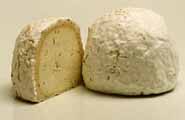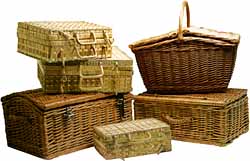|
Cheese
Focus Cheese
Focus Cheese Focus
 |
Gaperon
Haute Auvergne,
France
|
Gaperon is
a small cheese flavoured with pepper and garlic. It has a white
fluffy coat and is shaped into a dome which looks like a tiny
igloo. Originating in the region of the pink garlic of the Limagne
plain, in the Haute Auvegrne, Gaperon has been made and enjoyed
for centuries.
Milk which
is left over in the churn after butter-making is mixed with fresh
milk to make the cheese curds. The curds are then mixed with the
local pink garlic and pepper. Since buttermilk is used, the resulting
cheese is slightly lower in fat, generally 35%. The origin of
the name 'Gaperon' is taken from the local French dialect for
buttermilk which is 'gap' or 'gape'.
Over the centuries
Gaperons were hung in the farmhouse kitchen or the storeroom.
The number of cheeses gave an indication as to the farmer's wealth
and as such would have an influence on the marriage of his daughters.
Cheeses were sometimes tied with yellow ribbons and offered as
wedding gifts or harvest symbols, a decoration still in use today.
Stored in the farmhouse the white coat would acquire a mottled
colour of grey and blue as the spores in the air found their way
onto the surface of the cheese
Our Gaperon
is made using the same ancient methods and the cheese will taste
very similar to the ones enjoyed by the ploughmen and dairymaids
of the 14th Century. They are no longer matured in the farmhouse
kitchen but on rye straw in a damp cellar for one to two months.
Each cheese measures 75mm in diameter, 75mm in height and weighs
approximately 300 grammes. Gaperon is available all year round
with no particular best season, principally because of the pepper
and garlic flavouring. Gaperon is best enjoyed with a full-bodied
red such as a CÙtes du Rhone.
back to top
|
ANSWERS TO THE WORDSEARCH COMPETITION
The wordsearch contains the names of twenty-one
cheeses; fifteen cheeses which we stock at our shops together
with six more unusual cheeses which one day we hope to feature
as 'Cheese of the Week'.
Answers across
| M |
U |
N |
S |
T |
E |
R |
B |
P |
|
|
| A |
R |
O |
O |
S |
B |
A |
R |
I |
L |
C |
| N |
D |
G |
A |
D |
R |
C |
A |
C |
A |
H |
| C |
A |
R |
S |
T |
I |
L |
T |
O |
N |
E |
| H |
G |
U |
B |
B |
E |
E |
N |
D |
G |
S |
| E |
|
Y |
|
F |
E |
T |
A |
O |
R |
H |
| G |
J |
E |
T |
O |
S |
T |
|
N |
E |
I |
| O |
U |
R |
D |
E |
R |
E |
|
|
S |
R |
| G |
I |
E |
N |
T |
O |
M |
E |
T |
T |
E |
| S |
A |
I |
N |
T |
M |
A |
R |
C |
E |
L |
Answers down
| M |
U |
N |
S |
T |
E |
R |
B |
P |
|
|
| A |
R |
O |
O |
S |
B |
A |
R |
I |
L |
C |
| N |
D |
G |
A |
D |
R |
C |
A |
C |
A |
H |
| C |
A |
R |
S |
T |
I |
L |
T |
O |
N |
E |
| H |
G |
U |
B |
B |
E |
E |
N |
D |
G |
S |
| E |
|
Y |
|
F |
E |
T |
A |
O |
R |
H |
| G |
J |
E |
T |
O |
S |
T |
|
N |
E |
I |
| O |
U |
R |
D |
E |
R |
E |
|
|
S |
R |
| G |
I |
E |
N |
T |
O |
M |
E |
T |
T |
E |
| S |
A |
I |
N |
T |
M |
A |
R |
C |
E |
L |
The fifteen cheeses we stock at our shops are:
Brie, Cheshire, Esrom, Feta, Gjetost, Gruyere,
Gubbeen, Langres, Manchego, Munster, Picodon, Raclette, Saint
Marcel, Stilton and Tomette.
The six more unusual cheeses are:
Bra - An Italian cheese from Piedmont.
A dense, strong, salty, cow's milk cheese with a thick light brown
rind. Not for faint hearts.
Gad - A springy, yellow, loaf-shaped, cows' milk cheese
with scattered small holes. Made in Israel.
Gien - From Orléanais, France this is a cows' (or cow blended
with goat) milk cheese which is matured for a month to give a
pronounced nutty flavour. It is often wrapped in a Chestnut leaf.
Ourde - Similar to the famous 'Pyrénées'
ewes' milk cheese but made outside the strict AOC boundaries and
so cannot carry the name. Instead the name of the village in which
it is made is used.
Roos - A strong, salty cheese made with goats' or ewes'
milk in Iraq. It is molded and pressed by hand into grapefruit-sized
balls and ripened for six months.
Urda - A soft, whey cheese eaten with herbs as a spread
or used in cooking. Made in Czechoslovakia and parts of the former
Yugoslavia.
|
|
Our
new brochure is now available.
Our new brochure
is now out and includes many more products and much more information.
Cheese
selections - Each cheese monger has put together a balanced
cheese selection which includes some of their favourites.
Cheese
List - The cheese list now includes a photograph of each cheese,
provides discounts for whole cheeses and indicates which cheeses
can be sent worldwide.
Hampers
- A new and wider range of hampers and the opportunity to
design your own using any of the products in the brochure.
Wine and
cheese accessories - now stocked in our larger Kew shop. All
are available by mail order and for collection from Teddington.
If you need
any help or advise then please do not hesitate to telephone us
on 0208 940 1944
back to top

|